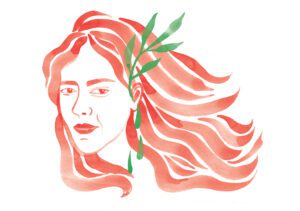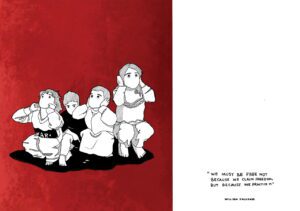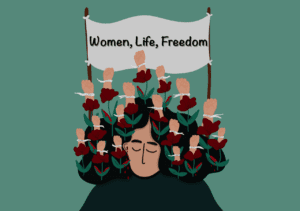Isabella Chiadini
 Two long panels covered with over 800 postcards occupy the corridor of the Collamarini Wing of the Bologna Academy of Fine Arts. One in a row, until they compose an installation, they are neither greeting cards nor postcards. These are the works that hundreds of Iranian men and women (resident in Iran or abroad) have sent to Bologna in response to the invitation of the students of the Academy. Bumblebees is the Collective of Iranian students and artists who conceived and curated the project with the support of the student council. The two guiding images of the collective call were drawn by the artist and human rights activist Gianluca Costantini, who recounted how proud he was of his collaboration with the students.
Two long panels covered with over 800 postcards occupy the corridor of the Collamarini Wing of the Bologna Academy of Fine Arts. One in a row, until they compose an installation, they are neither greeting cards nor postcards. These are the works that hundreds of Iranian men and women (resident in Iran or abroad) have sent to Bologna in response to the invitation of the students of the Academy. Bumblebees is the Collective of Iranian students and artists who conceived and curated the project with the support of the student council. The two guiding images of the collective call were drawn by the artist and human rights activist Gianluca Costantini, who recounted how proud he was of his collaboration with the students.
“It is today’s Iran with its struggles for freedom and its hopes for the future” declared Yasamin Marzooghfarhani of Bumblebees to the journalist of TG3 RAI during the inauguration of the exhibition; while Costantini emphasizes that what we see ‘is an action rather than a real exhibition’ everyone was admitted; well-known artists and people ‘who have sent a simple photo or a simple writing: like postcards, they range from very high levels to very familiar levels’.
In fact, upon entering, one is immediately struck by an enveloping and almost shapeless mass of colours. The overview anticipates what we will see without there being a work which is given more prominence than others; without a hierarchy and without a subdivision by theme or by techniques. So the closer you get, the more the ginning dissolves; and image after image the peculiarity of each work emerges. It is precisely by getting closer that each postcard represents an original and free point of view; but it is the subjectivity of the eye of the beholder, most struck by this or that detail, by a line, by a colour, by a text, that makes that postcard singular. Each work is a microcosm and resumes its place as soon as you take your eyes off it to look at another one; however there are some that, in different ways in each of us, demand more attention. So we are forced to go back, to linger on their call to look at them.
The image of Mahsa Amini, the 22-year-old of Kurdish origin, whose death in prison for wearing the veil incorrectly triggered the protests of October 2022, recurs, reworked in different ways, in many postcards; many thank and pay homage to The Queen, as she is now called, and the slogan ‘Woman, Life, Freedom’ seals many of the works on display.
The slogan of Kurdish independence groups has merged with the protests of Iranian youth movements, a generational movement that is becoming something more. A rallying cry, so insistent during the demonstrations as in these works, is not a tinsel, or a ritual that one could imagine already worn out. What emerges is the strength and depth in the visual choices, which evoke, even on a sensory level, the desire for rebirth and renewal. And above all, the reiteration of those three words indicates how compact is the collective sharing of the meaning that Iranian men and women give to protest: they ask for a society rebuilt in the name of freedom.
‘The mural of postcards we see is a wall that screams freedom’ declares Denise Duina, vice president of the Student Council, recounting the incredibly positive response that the appeal received during the same television programme.
‘Jin, Jiyan, Azadi’ shouted a group of female students on October 29, 2022 from a classroom at the University of Tehran; and they sang ‘Rise up! In the name of women, of life, of freedom. Let us free ourselves from the shackles of slavery […]’. Marzooghfarhani explains, confirming the impression one gets when looking at the processions and this mural that, ‘above all, women are the source of inspiration for this revolution’. Unfortunately we know it: it is on women and on the control of their bodies that oppression almost always takes place. But it is equally true, as underlined by the expert on Iran and Italian journalist Luciana Borsatti, former ANSA news agency bureau chief in Tehran, presenting her book Il Tempo delle Donne (Castelvecchi Editore, Rome 2023) to Antonella Alba (RAI Cultura 05.31.23), that ‘A change has started, certainly irreversible and profound, in Iranian society and culture, which is led by women; women take charge not only of their own rights but of a series of questions that come from all of society […]’. Yasamin Marzooghfarhani, from the Bolognese student collective, also chants the slogan Woman Life Freedom in front of the camera. Which said like this, with that emotion and that pride, expresses the granite will not to withdraw from those principles, in addition to the strong sense of community and belonging to a movement that will be hard to stop. The battle against the use of the veil has become, continues Borsatti, “a topic of confrontation and civil disobedience, a symbol of a wider and more transversal battle that has involved all levels of society; not only women but also men, students, the elderly and the workers”.
All of this is continuing despite in recent days – June 20, 2023 – the United Nations High Commissioner for Human RightsVolker Türk declared that the Islamic Republic is only formally committed to collaborating with the Agency , and according to reports leaked through Norwegian human rights groups in Iran, at least 142 people were reportedly sentenced to death in May 2023; without counting the arbitrary detentions and summary trials.
On that mural in Bologna I read many slogans that reproduce now recognized (almost) universally principles; the basic freedoms, human, civil and political rights which cannot be ignored but, as Borsatti explains “If the right to freedom is irrepressible and radical, if claiming it is already revolution, if its value is fundamental, nothing is simple when we are talking about Iran”. Nothing is simple but it will be irreversible and profound: yes, that’s that.
 The tone of some of those works is irreverent, brazen, explicitly directed both against the hypocritical intransigence of the regime and against symbols considered unassailable: the veil, the turbans of the ayatollahs – trampled and kicked. The hair cut, another symbolic image of these protests, declares the will for radical change. Flags appear among the symbols, to underline the desire for a free country, where plurality of thought could finally be under the same banner. The flags also remind us that Iran has a millenary civilization to rediscover; as the students of Tehran sing “[…] So that we become sprouts, I, you, the others, we become again what we are. […]”
The tone of some of those works is irreverent, brazen, explicitly directed both against the hypocritical intransigence of the regime and against symbols considered unassailable: the veil, the turbans of the ayatollahs – trampled and kicked. The hair cut, another symbolic image of these protests, declares the will for radical change. Flags appear among the symbols, to underline the desire for a free country, where plurality of thought could finally be under the same banner. The flags also remind us that Iran has a millenary civilization to rediscover; as the students of Tehran sing “[…] So that we become sprouts, I, you, the others, we become again what we are. […]”
Many works shout and claim, even angrily, the will of those who sent them not to give up and to stay alive. One photograph shows a woman with bruises, presumably from being beaten; back and arms wounded by whipping. Slightly curved shoulders and hair brushed forward as if she were ready to visit a doctor who declares her salvation or not. We cannot help but see and feel, in that body, the effort to expose humiliation and fragility. But the woman, standing despite everything, submits herself to our gaze: she imposes herself, overcoming anguish and shame. She demands we watch her. The image is a slap in the face, it wakes us up from our torpor and we can only feel the pain, and at the same time the courage, of whoever conceived, created that work and sent that postcard. The author is a man, talking about sharing intentions and painful situations for almost everyone living in Iran.
A veiled woman, seen from behind in a black and white photograph, walks next to a pillar on which we read freedom. It is probably the same word that has already appeared on another pillar, where an erasure can now be seen. But the word freedom comes back because it is impossible to erase it permanently. Its contrast with that dark veil makes the word even clearer and more indomitable. We don’t know if the woman is affected by it, we certainly are.
In other postcards the smiles, the chats between friends are striking. In a small painting, where color emerges, a group of women – uncovered faces, hair in the wind, arms raised in fists – float and occupy a space which, although delimited by the finiteness of the postcard, finally seems to be all theirs.
In front of the camera lens, children hug each other like footballers; a little shy and bold they make the sign of the V for victory. We smile with them, imagining that everyone can smile, not just for that moment. These postcards are a proposition of hope.
Others are more desperate, certainly protesting, but exuding disenchantment and pessimism: almost an acceptance of the lack of alternatives other than silence or annulment. But if even those works arrived there, one wonders, there must have been a vital force – and a kind of hope – that prompted that person to decide to send a sign saying ‘look at me, I’m here’. In fact, we see those women and men and feel them close. Closer than the media images, to which we risk becoming addicted. Furthermore, very few of those images have reached us directly because, as the journalist Luciana Borsatti declares, ‘it was not possible to document what happened from the area, yet we have a duty to go beyond this story’. The physical reality of postcards, by contrast, doesn’t just represent the work of the person who sent it; it gives a face to those who are committed to filling those postcard-shaped rectangles with words and bodies. They could be called postcards from bodies – Iranian women’s bodies above all, because they resonate with and are imbued by, their breath.
In an interview with the Italian newspaper La Repubblica, Yasamin Marzooghfarhani explains “Here I am an artist free to express myself. If I had stayed in Iran, like so many of my friends, I would not have had this chance. This is why my other companions and I wanted to create an installation that could give a voice to those who struggle: a large mural that unites hundreds of postcards against the Iranian regime”. A brilliant idea to have works sent in postcard format: this choice has given space to as many people as possible as well as once again having given art the role of messenger, in this case literally.
The transformative force of art is confirmed; art can corrode and mock power, it crosses borders and awakens the consciences of those who know little or do not know anything; and perhaps it was therapeutic for many of the Iranians who worked on the postcards. The whole operation, or the action as Costantini defined it, is a successful work. Let’s remember that we are talking about Iran, a country where even access to social media is controlled and some are blocked; yet these students have organized a network in which they circulate art and messages. Many minute stories arrived in Bologna, part of a larger story that is taking place. The collaboration of Gianluca Costantini, whose works in defense of human rights are known, has undoubtedly facilitated the widespread diffusion and visibility of the appeal. But the girls of the Bumblebees Collective, who are free to express themselves in Italy, as Yasamin Marzooghfarhani says, still have families and relatives in Iran; yet they exposed themselves, they are all so courageous; both the girls and those who sent the postcards. I think a climate of enthusiasm has been created in everyone: the Collective, the Council of the students, Costantini and the Direction of the Academy of Fine Arts. These are those events that occasionally happen in the name of a goal that requires courage, and make it seem almost easy when it could not have been.
Postcards From Iran
Bologna Academy of Fine Arts February 4-28, 2023

